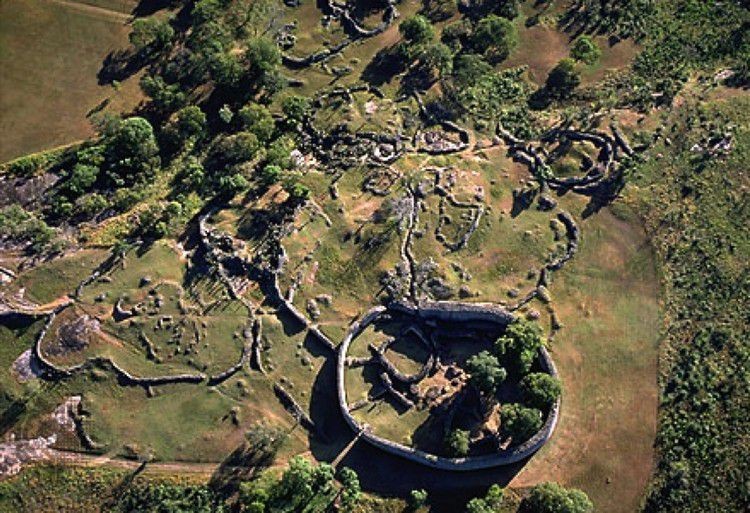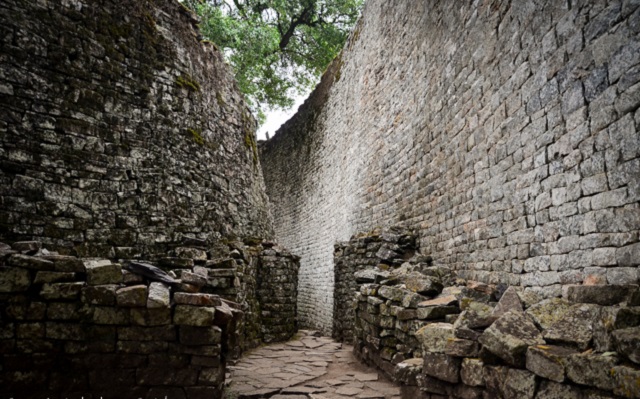
The Sunday News

Phathisa Nyathi
GAZING a majestic cultural edifice on the scale of Great Zimbabwe is synonymous with peering into the heavens. Architecture mirrors the culture of its creators, while that culture is informed by the world-view of the same creators. Where a people’s world-view is related to cosmic reality, we do well to spend time to understand that which informs the creators’ cosmology and world-view — the heavens. It is for this reason that we are spending time investigating the attributes of the cosmos from an Afro-centric perspective. It is that perspective which mirrors what they create, Great Zimbabwe being one such creation of the mind that seeks to copy heavenly reality. Great Zimbabwe was created and then built.
We have recently been looking at the attributes of African Aesthetics and, in that regard, we identified circularity, curvilinearity and the chevron design as such attributes. In retrospect, we realise that we should have dealt with movement before getting to understand the chevron design. Movement is one aspect of African Aesthetics which is easily identifiable in the various performing arts genres. Both music and dance embrace movement which is discernible to the ear and the eye.
Already we know that even sculpture, like a written piece of literature, embraces movement. As we shall see below, that movement is characterised by regularity. We saw how a chevron design does embrace rhythm, regularity, periodicity and, as a result, predictability.
When you find Africans clapping their hands during a dance performance, it is easy, within a short space of time, to join in the clapping of hands. This is so because there is predictability, an important attribute in the arts and in aesthetics/beauty. We should thus see some close link between beauty or aesthetics and the arts. Similarly, there is the same link between architecture and aesthetics. If the heavens are beautiful, and from an African perspective it is, then African architecture is beautiful for it is a mirror of the heavens. It is attributes inherent in movement that we shall explore and, hopefully, these will be identified at Great Zimbabwe which we are giving a fresh look as an artistic creation with a form designed to convey one overarching theme. That overarching theme should equally be identifiable in the heavens if our argument that cultural creations in the African context mirror the heavens.
It is when we have considered quite a number of attributes that we may begin to identify one enduring cosmic or heavenly theme. As in literature, a theme may be portrayed brought out through different plots or storylines. The critical question then is, what is the storyline which brings forth the theme? A theme in a literary work is a product of creativity. So it is with cultural edifices which are products of a creative mind. What is created bears a bit of the mind of its creator. An ilala basket bears the signature of the basket maker. At the same time, the resulting creation is never divorced from the signature of the broader community. A signature is a language of the created, and by extension, the language of the creator, and thus a passport into the mind of the creator. Have we not read it that God created in his own likeness and image? There is thus a bit of God in everything that He created.
Before proceeding any further, we do well to refer to procreation. Essentially, it is creation, one that refers to human beings.
One attribute of creativity is that its products are unique. What is created may not be repeated. What has been procreated is unique and different. In Biology we may refer to genotype. Each individual, being a product of creation, is unique and this is borne out in his/her genetic makeup. Creativity is not characterised by mass production. A song is created, a DVD or CD is mass produced. Creativity and production are not the same. Human settlements may be created from stone but there will never be two identical Zimbabwe type settlements. Each does bear the signature of the broader community while each also carries its own individual and identifying artistic signature. In a cultural edifice such as Great Zimbabwe, there is thus a hierarchy of artistic signatures which locate it within the broader community context while simultaneously giving it its unique signature, its unique arrangement of chromosomes. Procreation, like other forms of creation, produces creations that are unique in their make-up.
Now we go further to identify the major characteristics of movement in artistic compositions, characteristics which are attributes of African Aesthetics. Artistic movement is characterized by repetition. There are many examples of such a phenomenon in nature. The seasons repeat themselves: summer, autumn, winter, spring; summer, autumn, winter . . . Essentially, this is repetition. It is a repetition that we find in a chevron design. Movement itself is repetition: left, right; left right; left . . . Day, night; day, night . . . this is repetition. The moon is another good example too. New moon (birth), full moon (growth and development), waning moon (death); rebirth . . . It goes on and on, ad infinitum.
We should immediately move on to the next attribute of African Aesthetics, which is indeed an attribute of nature/heavens.
Repetition is predictable as given above with regard to clapping of hands and stamping of feet and indeed, singing itself. The moon takes 28 days to complete its lunar cycle. Africans realized the similarity between the moon and women’s menstrual cycle, also a 28 day cycle. As a result the name for the moon is the same as that for menstruation. This happens to be the cycle of life. “Mens” in Latin refers to the moon. So even European languages such as English, which borrowed words from Latin, recognise the link between women and the moon. Our bodies are so tuned acclimatised to rhythm to a point where loss of rhythm is harmful to the body. The sleep-wake rhythm is very important for the body and when sleep is omitted, the body suffers.
How would human beings produce crops in the absence of seasonality? Imagine when summer was just setting in and all of a sudden, winter immediately sets in. The crops would not reach maturity and there would be hunger and starvation.
Sometimes we take rhythm for granted and fail to fully appreciate its role in ensuring continued life on the planet. In the absence of alternating day-night cycle, life is unimaginable. In the absence of rotation, which explains the day-night cycle, life is not possible. Even a simple biological process such as breathing exhibits the in-out cycle which is regular. Have you not seen the last kicks of a dying horse? There is irregularity which is what has given rise to the saying about the dangerous last kicks of a dying horse. Life is characterised by rhythm/regularity. When life exits an animal, there is sometimes evident irregular kicking. Rhythm is lost when life is lost. Climatic changes that are taking place translate to loss of rhythm. Rains come late which is a departure from known regularity.
The critical question is whether or not these attributes can be isolated and identified at Great Zimbabwe. If indeed, they are found, then our argument will be vindicated or hold water, namely, that Great Zimbabwe is an artistic creation as expressed in terms of African Aesthetics. It will then be argued that Great Zimbabwe is as beautiful as the heavens. The heavenly attributes of beauty are resident in the cultural edifice that we call Great Zimbabwe. Simultaneously, we will have proved that Great Zimbabwe is a magnificent and glorious work of art with a functional role. In African terms there cannot be beauty which is a stand alone. Beauty has always been borne by functional objects. Here we may turn to Chinua Achebe and observe the veracity of what he said, “Art for art’s sake is like deodorised dog shit.” Artistic rendition at Great Zimbabwe should, wily nily, carry elements of utility or functionality. It has to be explained why the colossal walls were erected. What was the Great Enclosure built for? Why was the Conical Tower built? Why were the Zimbabwe Birds sculpted? Why were the stelea (monoliths) on top of walls erected. A close look at African architecture even to this day will reveal a sense of unity among traditional huts, a phenomenon that is missing where a European house stands out like a sore thumb within a homestead.
Unity and relatedness are important in the universe and in African creations.
Our argument is that functionality or utility leads the way. A wall has a primary function that it performs even when it is notembellished. Why execute the chevron designs in part of the wall of the Great Enclosure and not the entire wall? Creative work at Great Zimbabwe was a conscious effort and not a hit and miss or haphazard affair. It was all organised work with all its individual parts contributing to the whole. Creating chevrons only on part of the wall must have been executed to represent and express some deep-seated theme. The wall, as we shall see, bears elements of African Aesthetics or African Beauty. The wall performs some primary utility, first and foremost. We thus see some important duality or marriage between utility and beauty, between architecture and beauty.
Going beyond the wall, we get to the chevron design. Essentially, or primarily, the chevron is a bearer of beauty or aesthetics and in itself is beautiful. As argued above, beauty in Africa was never created to be a stand alone. As expected, the chevron design is carried or borne by the wall. The chevron itself exhibits duality or marriage that we observed regarding the stone wall. Art equally carries utility or functionality and beauty. It just cannot be art for art’s sake. In art, there is a message that is conveyed to the consumers of art. The message being conveyed goes beyond mere consumption of art to equally perform a functional or utilitarian role. The all important consideration is, what is the message inherent in the chevron design? We shall indeed pose the same question with regard to other designs resident at Great Zimbabwe such as the herring bone, the chess board and dentelle. What we do know is that art communicates effortlessly.
We shall argue that any explanation and interpretation of Great Zimbabwe which fails to see the link between beauty/aesthetics and functionality/utility risks the danger of failing to read the language of Great Zimbabwe.
Beauty/aesthetics and functionality/utility, in togetherness or complementarity, provide the Rosetta Stone that decodes the language of Africa’s second largest architectural monument. Both art and architecture provide pointers to functionality or utility. Stone architecture endures, so does the language it speaks. If it were made of earth, the structure would have crumbled a long time ago and, in the process, Great Zimbabwe would have been gagged and its language joined the growing numbers of human languages that die each passing year and its legacy relegated to the dustbins of human history.
But lo and behold, Great Zimbabwe speaketh through stone!




